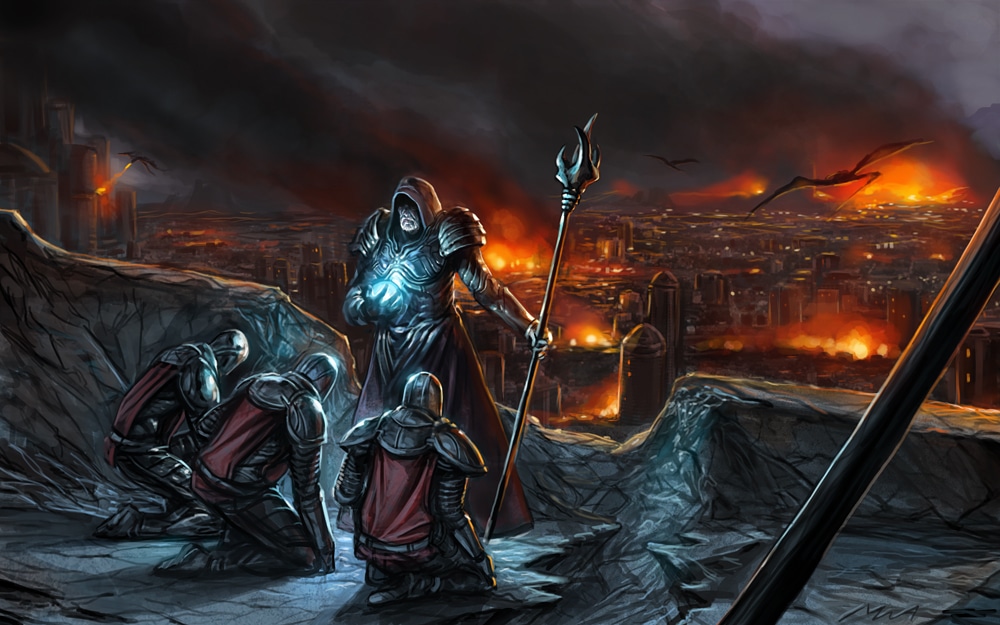Today we are talking about the 5e command spell. Specifically, an evaluation of the commands uses, some ideas to help spice it up, as well as the limits specified to the spell.
For those of you unaware, the command spell can be found on page 233 of the Players Handbook and states:
“You speak a one-word command to a creature you can see within range. The target must succeed on a Wisdom saving throw or follow the command on its next turn. The spell has no effect if the target is undead, if it doesn’t understand your language, or if your command is directly harmful to it. Some typical commands and their effects follow. You might issue a command other than one described here. If you do so, the GM determines how the target behaves. If the target can’t follow your command, the spell ends.
- Approach. The target moves toward you by the shortest and most direct route, ending its turn if it moves within 5 feet of you.
- Drop. The target drops whatever it is holding and then ends its turn.
- Flee. The target spends its turn moving away from you by the fastest available means.
- Grovel. The target falls prone and then ends its turn.
- Halt. The target doesn’t move and takes no action. A flying creature stays aloft, provided that it is able to do so. If it must move to stay aloft, it flies the minimum distance needed to remain in the air.
As you can see the spell comes with numerous uses that can be used in both combat and outside of combat purposes. Moreover, combine that with strong given uses but also the ability to create uses outside of the situation, means the possibilities are only limited by the few things mentioned in the spell.
Command 5e Limits
Speaking of the limits, let’s take a look at what the spell can and cannot do. The 5e command spell has a few noticeable points that limit the spell.
First, let’s take a look at the target of the spell. The spell states that the target in question must be (1) a creature that is living (2) understands your language and (3) perceives it as not directly harmful.
This means a drow that only knows undercommon while you don’t would be immune to the spell, but if you also knew undercommon then he becomes an able target.
Now that we know who the target of the spell may be, we need to take at the look of the casting of the spell as well. The rules for casting are established through it. The first part is the spell only requires a verbal component, meaning, you must be able to speak and they have to hear you then a link is established between the spell.
The second limit to the casting is that the command must be only one word. Therefore, “halt” works, but “stop here” does not.
Finally, the casting of the spell’s effect does not happen immediately, but on their turn. Meaning legendary actions and reactions happen just as usual for a creature since it is not technically on their turn. If you are wanting some additional information of the limits and maybe a few creative ideas then definitely check out this forum on D&D Beyond.
With these limits established to the 5e command spell, we can now move onto actual application.

Command 5e Stated Applications
Now that you know of what the spell can do, I am sure you can think of quite a few scenarios this can be used in. As such, before we get creative, let’s take a look at what is given to us to automatically work via the spell description.
Approach. A useful but niche version of the spell for those that wish to attack melee and can’t reach an enemy. This could be due to reasons such as they can fly or have a defensive line in front of them. Your best uses for this is against spellcasters since they are usually avoiding the front lines.
Drop. An extremely strong spell for those that wield deadly weapons. But only for that. Have an enemy barbarian pounding into your party that sucks the life force from the enemy? Tell them to drop to not worry about it and end their turn.
I do want to mention, many DM’s have ruled this that they can use their reaction to try and grab it when one of your allies try to take the weapon. So, be prepared for a second roll to take the weapon away.
Flee. There can be a lot of uses for this version. But each usually requires set up. If you can have your allies move into position then you can have them all use their reactions to hit the target as they flee from you. The other popular use is when the enemy gets too close to you and you want them to well, not be.
Grovel. The most popular of the uses. Usually used to proxy advantage for all melee attacks. This not only causes them to fall prone, but they use their entire action doing so. Thus giving allies the ability to do serious damage against the big bad and have the enemy waste their turn.
Halt. From most popular to least used. This just stops them in their place. Useful if they are attempting to flee, but so does grovel and the rest since they end their turn after performing the action. Making this the weakest of them all.
Command 5e Creative Uses
Now comes the fun part. Creating creative uses of the 5e command spell to alter it to your necessary needs.
Chances are, the five uses given will cover almost every need of yours. However, if you are like me, you like pushing the envelope to see the full potential each spell can have. So, with that said here are a few creative uses of it that I greatly enjoy for different situations.

Roleplay Creative Uses
We can all think of combative uses for the spell, but what about for outside of combat situations? Well, if you cannot think of any, you are in luck because here are two of my favorite roleplay uses of the 5e command spell.
Confess. An extremely powerful use of the spell. Can be either hilarious or useful depending on your DM. After all, it never specifies what they are supposed to confess. Confess about their love life? Or perhaps confessing to the secret plot that is going on behind the scenes.
Now why it can be extremely powerful, you might have to use it a few times as they only confess for six seconds. And why you might get a few details the big bad for the campaign definitely has a plot that takes longer than 6 seconds to tell.
Sign. I am big on signatures. After all signatures from key people can gain you access to unique areas, or get you out of trouble. In fact a spell, I always choose is illusory script because for documentation, it is the most broken spell there is. If you want to read all of the numerous uses for it, then you definitely need to check out my post on the best wizards spells we don’t think about. But, if you don’t have access to illusory script, then 5e command should do the trick. Just put the document you want in front of them and command them to sign. Chances are they will and you have the document you need.
But be warned, he will know he was influenced to sign it, so some serious repercussions could occur. But definitely with some creative thinking can mean the adventure you have just got that much easier.
Combat Creative uses
Now comes for the most common kind of uses for the command 5e spell, combat uses. Combat is an integral part for Dungeons and Dragons. As such, whenever a spell is read, most peoples immediate thought, is how effective is the spell in combat. Well, this one already has a ton of uses for combat, but here are two creative ones that might help you.
Defenestration. Okay, chances are, you may not know what this word means. It basically means “to throw yourself or something out of a window”. Now that you know what this word means, you can use it on your enemies to where they may throw something of value, such as a sword or themselves, out the window. But, be warned, it will probably be only useful against those with high intelligence as your common thug probably doesn’t know the definition.
Deactivate/Release. Another of my favorite uses when either trapped, imprisoned, or fighting a spellcaster. For example, if you know there is a trap and need to get past it, just have the enemy who knows about it, deactivate it and now you no longer need to worry about it. Another example is when a spellcaster is concentrating on a spell like haste. Tell them to deactivate or release it. While there is a chance the DM might rule this another way, the ability to turn off a concentration spell from an enemy is incredibly potent, especially for a 1st level spell slot.
Conclusion: Command 5e
As can be seen, with just a few creative uses and an understanding of who and what the spell targets, can mean with a level 1 spell you can alter entire combat with just a few simple alterations to the spell. Making this a powerful spell for anyone’s arsenal and a spell every DM should know the rules and watch out for in their sessions. As mentioned before, if you enjoy the creative ideas for this spell. Then you will love my talk on the best wizard spells we don’t think about. As it is filled with goodies just like this that can be used in you D&D sessions. I hope you have a wonderful day and continue to enjoy the game… and my posts!
- P.S. If you enjoyed this post and others like this, subscribe to my Patreon and help decide on what content will be released as well as get exclusive posts only available to subscribers with all charts used included!

